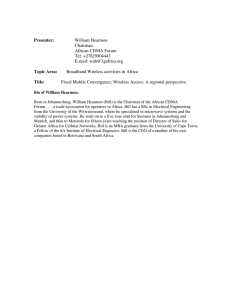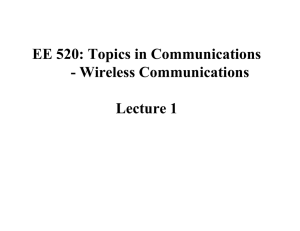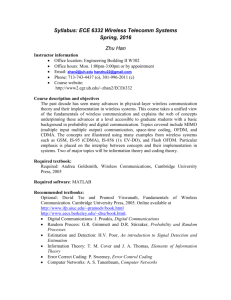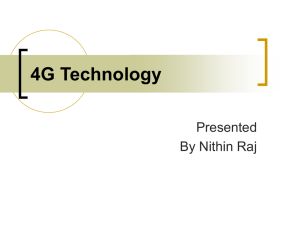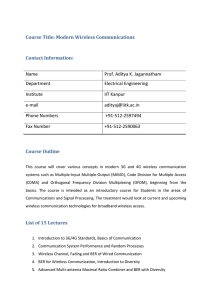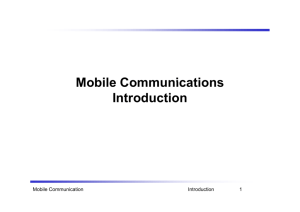File
advertisement
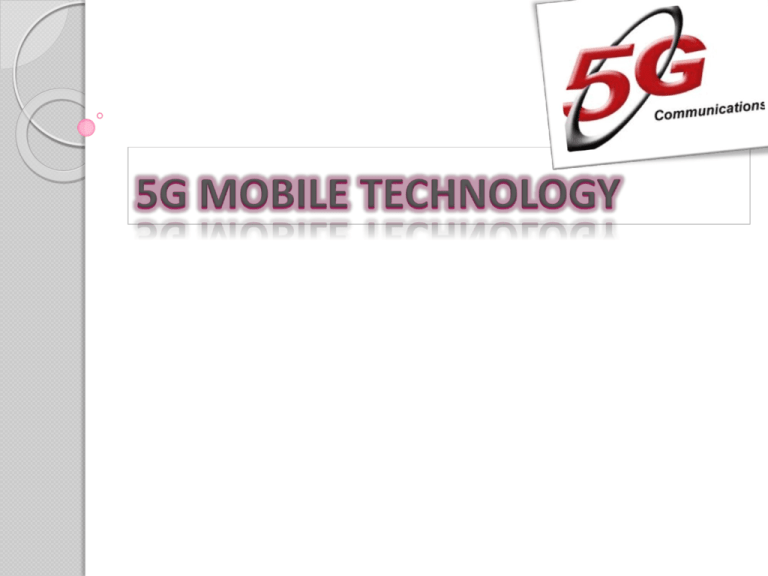
1st GENERATION: Introduced in 1980 Analog cellular mobile. Data rate: 2.4kbps 1G mobile schemesAMPS,NMT,TACS Uses FDMA technique with 30KHz 2nd GENERATION: Also Known as Digital cellular systems Digital modulation schemesTDMA,CDMA Data speed in 2g is up to 64kbps Data speed in 2.5g is up to 144kbps Roaming was introduced GPRS, EDGE and CDMA 2000 were 2.5 technologies. 3rd GENERATION: 3g technology is intended for true multimedia cell phone Increased bandwidth and transfer rates to accommodate wed-based applications and phone-based audio and video files Pure IP based services universal global roaming multimedia (voice , data & video) 384 kbps while moving 2mbps when stationary at specific locations video calling OVERVIEW OF 3 GENERATIONS 4th GENERATION: high-speed data access Datarate :>100Mbps high quality streaming video combination of wi- fi and wi-max SDR,OFDM,OFDMA WHAT IS 5G??? 5G is a packet switched wireless system with wide area coverage and high throughput. 5G wireless uses OFDM data rate of 20 mbps frequency band of 2-8 GHz. 5G is going to be a packet based network. OBJETIVES OF 5G: 5G being developed to accommodate QoS rate requirements set by further development of existing 4G applications. Flexible channel bandwidth between 5 and 20MHz, optionally up to 40MHz. Data rate of at list 1Gb/s between any two points in the world. Increase system spectral efficiency of up to 3bit/s/Hz/cell in the downlink and 2.25bit/s/Hz/cell for indoor usage. STANDARD WIRELESS 5G: WiMAX formed to provide conformance and interoperability of the IEEE 802.16 standard. It aims to provide wireless data over long distance from point-to-point link to cellular mobile type access. WiBRO a part of IEEE 802.16e in process to provide collaborative and generic mobile WiMAX. 3GPP LTE a project aims to improve the mobile phone standard to cope with future requirements. 5GPP 2 UMB a project to improve the CDMA2000 mobile phone standard for next generation applications. 5G NETWORK REFRENCE MODEL: IPv6 SUPPORT: IPv6 increases the IP addresses size from 32bit to 128 bits, to support more levels of addressing hierarchy and much greater number of addressable node. IPv6 support large number of wireless enabled devices. IPv6 Extend the IP address space enough to offer a unique IP address to any device. IPv6 Improve support for IP Mobility. 4G Vs 5G 4G(2000-10) 5G(2010-15) Switching All packets All packets Service Dynamic information access, wearable devices Dynamic information access, wearable devices with AI capabilities Data rate Up to 20Mbps Up to 1 Gbps Technology combination of broadband, LAN/WAN/PAN/ WLAN and wwww combination of broadband, LAN/WAN/PAN/WLAN and wwww Standards Single unified standards Single unified standards Multiplexing CDMA CDMA BENEFITS OF 5G: High speed, high capacity, and low cost per bit. Support interactive multimedia, voice, streaming video, Internet, and other broadband services ,more effective and more attractive ,Bi directional ,accurate traffic statistics. Global access, service portability, and scalable mobile services. The high quality services of 5G technology based on Policy to avoid error. 5G technology is providing large broadcasting of data in Gigabit which supporting almost 65,000 connections. 5G technology offer transporter class gateway with unparalleled consistency. Through remote management offered by 5G technology a user can get better and fast solution. APPLICATIONS: How could be it.. If you can able to feel yours kid stroke when she/he is in her mother’s wombs. If you can able to charge your mobile using your own heart beat. If you can able to perceive your grandmother sugar level with your mobile. If you can able to know the exact time of your child birth that too In Nano seconds. If your mobile rings according to your mood. If you can Vote from your mobile. CONCLUSION: Migration to 5G networks ensures convergence of networks, technologies, applications and services. 5G can serve as a flexible platform. Wireless carriers have an opportunity to shorten Investment return, improve operating efficiency and increase revenues. 5G - a promising Generation of wireless communication that will change people’s lives.


